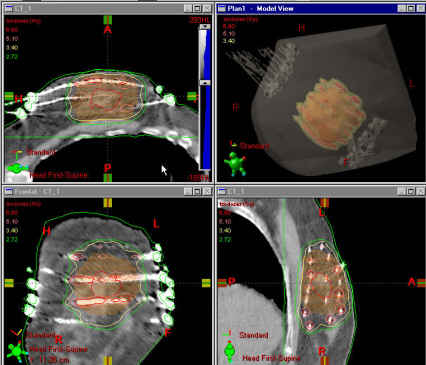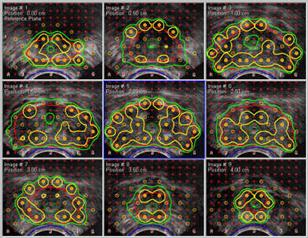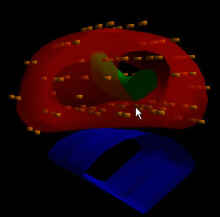Breast, gynecologic and prostate brachytherapy

During brachytherapy, devices containing radioactive material are placed directly into the body tissue. These devices can include wires, balloons or tiny seeds using needles or special applicators. This allows radiation to go directly into the tumor. A CT scan or ultrasound will be used during brachytherapy to ensure delivery is being placed with precision.
At VCU Massey Comprehensive Cancer Center, we currently offer brachytherapy for breast, gynecological, and prostate patients.
 Photo: A radiation treatment plan for multi-catheter breast brachytherapy.
Photo: A radiation treatment plan for multi-catheter breast brachytherapy.Breast brachytherapy is used for accelerated partial breast treatment. Traditional radiation therapy for breast cancer involves approximately six weeks of daily external treatments. Some women are candidates for partial breast treatment, which is a promising new treatment delivered over just five days. Several methods of partial breast treatment are available at Massey, including multi-catheter implants, both the Contura and MammoSite devices, and three-dimensional conformal external beam therapy.
Several protocols continue to be available in the area of breast brachytherapy that allow patients to have access to the latest treatment approaches.
In those patients receiving whole breast irradiation for early stage breast cancer, we offer AccuBoost technology for boost dose delivery to the tumor bed. AccuBoost is offered in our brachytherapy suite as an option for treatment when appropriate. This non-invasive treatment combines target visualization and localization capabilities with accurate dose delivery to optimize boost dose conformance.
Vaginal Cylinder Brachytherapy
This is typically used for women who have had a hysterectomy for cancer and require some additional treatment to prevent a recurrence. This treatment is performed as an outpatient and no anesthesia is required. A vaginal cylinder looks similar to a hollowed out tampon and is placed into the vagina much like during a standard pelvic exam. Once in position, the cylinder will be connected to a machine that delivers radiation into the applicator. You will not feel anything during treatment and the duration is typically 5-10 minutes. The applicator is removed after treatment is completed. The number of treatments is recommended by your physician, but is usually 3-5 treatments with 1-2 days between visits. Many women will be given a vaginal dilator to use once your treatment is completed to prevent vaginal scarring for future intercourse and pelvic exams.
Tandem Based Brachytherapy
Tandem and ovoids (also sometimes tandem and ring, or with the addition of customized applicators) are used primarily to treat cervical cancers. This procedure is performed under anesthesia and involves placing an applicator into your uterus through your vagina. This insertion is guided through ultrasound. Once the applicator is in position, a scan (CT or MRI) is acquired to assist in developing a customized treatment plan to your anatomy and disease. The applicators are then connected to a machine that delivers radiation treatment. Treatments are typically delivered in 4-5 fractions (typically two fractions a week) and are often concurrent with external beam radiation therapy.
Tandem-based brachytherapy is also recommended for women with endometrial cancer who are unable to have surgical removal of the uterus (hysterectomy).
Interstitial Brachytherapy
This type of brachytherapy is most commonly used for more advanced or recurrent gynecologic cancers. This is an inpatient procedure where an implant (consisting of multiple thin catheters) is inserted into your vagina under anesthesia and remains in place for three days while you receive your treatments. Often an MRI scan is acquired a few days before the procedure, allowing the team to create a highly customized insertion plan. After the implant insertion, a CT or MRI scan is acquired and a final treatment plan is created. The first radiation treatment is delivered shortly after the implant insertion.
The applicators are connected to a machine that delivers radiation treatment. Four-to-five radiation treatments are typically delivered that last about 10-15 minutes, twice per day (a.m. and p.m.) with implant removal after the last radiation treatment. After each treatment, the radiation delivery device is disconnected so you are not a risk to others at any time - you can have visitors, nurses and other staff in your room. We use an epidural or other method of pain medication delivery during the hospital stay so that you are comfortable.
The Massey team has pioneered an applicator insertion technique which combined with mathematical plan optimization aims to deliver maximum of dose to the disease while sparing as much normal anatomy as possible, thus minimizing side effects.
Both permanent and temporary prostate implants are available to our patients. Permanent implants (low dose rate, or LDR) involve the placement of many tiny radioactive seeds into the prostate gland under ultrasound. These implants are done in a single session. For temporary implants (high dose rate, or HDR), hollow catheters are placed into the prostate. A high-activity radioactive source is then fed under computer-control into each catheter and then removed. Temporary implants often can be done in one or two sessions. Both LDR and HDR implants can be done as the sole treatment for prostate cancer, or in some circumstances, in combination with external beam radiation.
 Photo: A radiation treatment plan for permanent prostate seed brachytherapy.
Photo: A radiation treatment plan for permanent prostate seed brachytherapy.
 Photo: A three-dimensional rendering of seed positions for permanent prostate brachytherapy.
Photo: A three-dimensional rendering of seed positions for permanent prostate brachytherapy.
